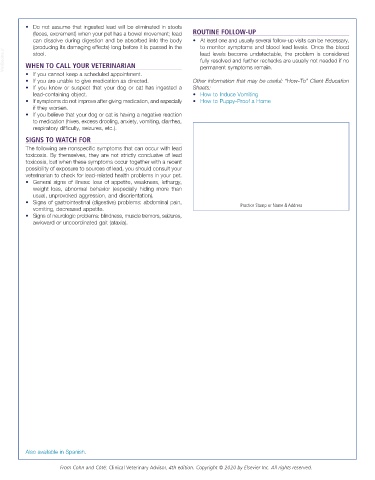Page 3057 - Cote clinical veterinary advisor dogs and cats 4th
P. 3057
• Do not assume that ingested lead will be eliminated in stools
(feces, excrement) when your pet has a bowel movement; lead ROUTINE FOLLOW-UP
can dissolve during digestion and be absorbed into the body • At least one and usually several follow-up visits can be necessary,
(producing its damaging effects) long before it is passed in the to monitor symptoms and blood lead levels. Once the blood
VetBooks.ir WHEN TO CALL YOUR VETERINARIAN fully resolved and further rechecks are usually not needed if no
lead levels become undetectable, the problem is considered
stool.
permanent symptoms remain.
• If you cannot keep a scheduled appointment.
• If you are unable to give medication as directed. Other information that may be useful: “How-To” Client Education
• If you know or suspect that your dog or cat has ingested a Sheets:
lead-containing object. • How to Induce Vomiting
• If symptoms do not improve after giving medication, and especially • How to Puppy-Proof a Home
if they worsen.
• If you believe that your dog or cat is having a negative reaction
to medication (hives, excess drooling, anxiety, vomiting, diarrhea,
respiratory difficulty, seizures, etc.).
SIGNS TO WATCH FOR
The following are nonspecific symptoms that can occur with lead
toxicosis. By themselves, they are not strictly conclusive of lead
toxicosis, but when these symptoms occur together with a recent
possibility of exposure to sources of lead, you should consult your
veterinarian to check for lead-related health problems in your pet.
• General signs of illness: loss of appetite, weakness, lethargy,
weight loss, abnormal behavior (especially hiding more than
usual, unprovoked aggression, and disorientation).
• Signs of gastrointestinal (digestive) problems: abdominal pain,
vomiting, decreased appetite. Practice Stamp or Name & Address
• Signs of neurologic problems: blindness, muscle tremors, seizures,
awkward or uncoordinated gait (ataxia).
Also available in Spanish.
From Cohn and Côté: Clinical Veterinary Advisor, 4th edition. Copyright © 2020 by Elsevier Inc. All rights reserved.

